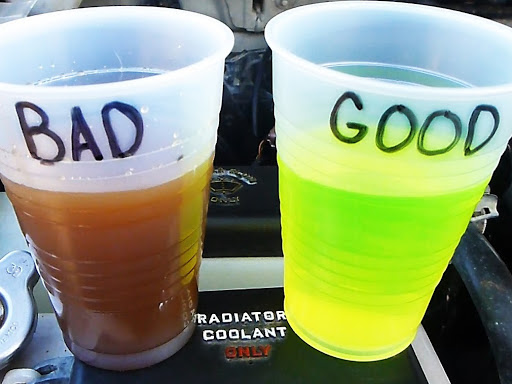
As a car driver, it is important that you know the basics to know what is happening to your vehicle, so if you notice that the radiator water turns brown, you should be wondering if a brown coolant is normal or not. Fortunately for you, below we will explain why your refrigerant turns brown, the causes and what to do when this happens.
What does the coolant do?
First of all, the first thing you need to know is the function of the coolant. Coolant flows through the radiator, water pump, water hoses, and internal engine passages to prevent the engine from overheating. If he coolant level it is too low, too dirty or contaminated, it cannot cool the engine properly. Today’s vehicle engines cannot handle excess heat, so if the engine overheats, it can lead to catastrophic damage and costly repairs.

Why did the water in the radiator turn brown?
It is not normal for the water in the radiator to turn brown or brown. But it is not strange, and the most logical answer is that your coolant is rusty. When your coolant becomes light brownthe problem must be in the head gasket which may be burned or broken by rust. Corrosion is a common cause. It can also be due to boiling coolant.
Meanwhile, if your refrigerant becomes dark brown, this occurs mainly in cast iron engines where the coolants have not been changed recently. A fresh coolant has corrosion inhibitors and prevents the block and other iron components from rusting.
So over time the block will wear such inhibitors and they will start to rust from the inside out. Rust will give old coolant an orange-brown and dark brown color, plus slimy oil in your coolant will turn it brown.

Why is my coolant reservoir brown?
Brown sludge can cause incompatible coolant mixing and coolant not being drained often enough. There may also be a problem with rust and corrosion causing the coolant reservoir to turn brown.
What if my coolant is brown and thick?
If your coolant is thick and brown, you have some trouble. This color and texture can indicate serious problems, including a cracked block or blown head gasket, as well as a leaking water pump gasket.

Why does my coolant look dirty?
If your coolant looks contaminated. It may be because of a blown head gasket or a broken head will allow the oil and coolant to mix. This will result in sludge.
If your vehicle has automatic transmission, the engine cooling system will cool the transmission. There will also be a breach in the system and you will contaminate the coolant with the transmission fluid.
Why is my coolant rust colored?
Rust in your cooling system can be caused by air getting into your radiator if the engine cools down. If your coolant gets cold, it will contract and cause an air pocket. The overflow tank will also hold enough coolant to keep the radiator full even in cold temperatures.
However, if there is no overflow tank, air will enter the cooling system through a radiator cap if the coolant contracts. Which will lead to rust and wear of the water pump seal and bearings.
What does “clean” coolant look like?
The coolant that is still doing its job to protect your engine can be any variety of colors, from green to red to orange, but the key is that it be translucent. When it is past its prime it will fade to a brownish and duller color, like coffee, although if it is in very bad shape it will be a muddy brown.
Allowing the coolant to deteriorate could affect your vehicle’s cooling system. You can tell this by looking at some common signs of trouble, such as:
- A low coolant level warning light.
- A Check Engine or Service Engine Soon light.
- The engine temperature gauge goes to the red zone.
- Low coolant levels.
- Refrigerant leak.
- Steam from under the hood.
- Fresh or cold air coming from the heating vents.
- A cooling system flush can help prevent these problems.

What should I do if the water in the radiator turns brown?
If you notice that your coolant turns brownyou need to drain the coolant, as well as flush the system so you can put in some fresh, new coolant.
Since it turns brown from rust and corrosion. You can replace your old coolant with a new one that has active anticorrosives.
When should I bleed my coolant?
Each auto manufacturer recommends a different schedule for flushing the coolant. While we recommend using your owner’s manual as a starting point, you should periodically check the condition of your coolant.
How much does a refrigerant flush cost?
A coolant flush or cooling system flush is modern terminology for removing rust, dirt, sludge, and old antifreeze or “radiator fluid” from your radiator.

The cost of this service varies from store to store, depending on the level of service they provide. Remember that a “drain and fill” is not the same as a coolant flush, draining dirty coolant from the radiator and refilling it with clean coolant will not remove dirty fluid inside the water hoses, water pump or engine cooling ducts.
You should choose a mechanical workshop have a machine to completely remove dirt, contaminants and aged coolant from the entire cooling system, not just the radiator. Otherwise, you’re spending money to do only a fraction of the job. But the cost of this service should not be excessively expensive, it should be around $40 – $50 dollars.
IT MAY INTEREST YOU:
- Organic or inorganic coolant
- 7 symptoms of a clogged radiator
- How to clean a radiator with vinegar and baking soda
Sources: autolaliberty Y piketransit



